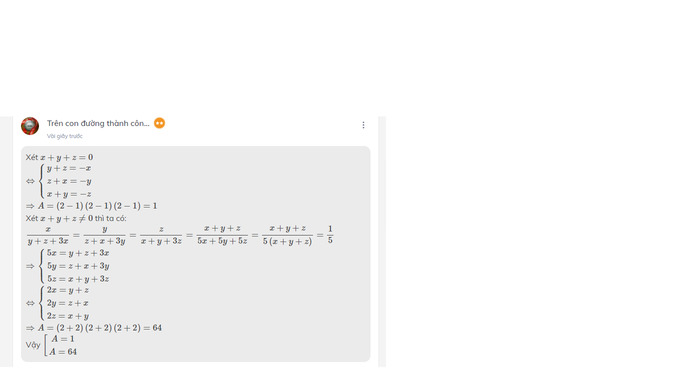Hãy nhập câu hỏi của bạn vào đây, nếu là tài khoản VIP, bạn sẽ được ưu tiên trả lời.

\(\dfrac{-19}{23}< \dfrac{7}{x}< \dfrac{-19}{25}\\ \Leftrightarrow7:\dfrac{-19}{23}< x< 7:\dfrac{-19}{25}\\ \Leftrightarrow\dfrac{-161}{19}< x< \dfrac{-175}{19}\\ \Leftrightarrow-161< 19x< -175\\ \Leftrightarrow x=-9\)
Tìm các số nguyên x, y thỏa mãn 2x + 3y =19 và \(\dfrac{1}{3}\) < \(\dfrac{x}{y}\)< \(\dfrac{1}{2}\)

\(\dfrac{1}{3}< \dfrac{x}{y}< \dfrac{1}{2}\Rightarrow\dfrac{4}{12}< \dfrac{x}{y}< \dfrac{6}{12}\Rightarrow\dfrac{x}{y}=\dfrac{5}{12}\Rightarrow\dfrac{x}{5}=\dfrac{y}{12}\)
Áp dụng t/c dtsbn:
\(\dfrac{x}{5}=\dfrac{y}{12}=\dfrac{2x}{10}=\dfrac{3y}{36}=\dfrac{2x+3y}{10+36}=\dfrac{19}{46}\\ \Rightarrow\left\{{}\begin{matrix}x=\dfrac{95}{46}\\y=\dfrac{114}{23}\end{matrix}\right.\)
Mà \(x,y\in Z\)
Vậy ko có x,y nguyên thỏa mãn đề

a) Ta có:
\(A=\dfrac{-68}{123}\cdot\dfrac{-23}{79}=\dfrac{68}{123}\cdot\dfrac{23}{79}\)
\(B=\dfrac{-14}{79}\cdot\dfrac{-68}{7}\cdot\dfrac{-46}{123}=-\left(\dfrac{14}{79}\cdot\dfrac{68}{7}\cdot\dfrac{46}{123}\right)\)
\(C=\dfrac{-4}{19}\cdot\dfrac{-3}{19}\cdot...\cdot\dfrac{0}{19}\cdot...\cdot\dfrac{3}{19}\cdot\dfrac{4}{19}=0\)
Suy ra A là số hữu tỉ dương, B là số hữu tỉ âm và C là 0.
Vậy A > C > B.
b) Ta có:
\(\dfrac{B}{A}=\dfrac{-\left(\dfrac{14}{79}\cdot\dfrac{68}{7}\cdot\dfrac{46}{123}\right)}{\dfrac{68}{123}\cdot\dfrac{23}{79}}=-\dfrac{14}{79}\cdot\dfrac{68}{7}\cdot\dfrac{46}{123}\cdot\dfrac{123}{68}\cdot\dfrac{79}{23}\)
\(\dfrac{B}{A}=-\dfrac{14\cdot68\cdot46\cdot123\cdot79}{79\cdot7\cdot123\cdot68\cdot23}=-\left(2\cdot2\right)=-4\)
Vậy B : A = -4

Lời giải:
Áp dụng TCDTSBN:
$\frac{x}{y}=\frac{y}{z}=\frac{z}{x}=\frac{x+y+z}{y+z+x}=1$
$\Rightarrow x=y; y=z; z=x\Rightarrow x=y=z$
Khi đó:
$|x+y|=|z-1|$
$\Leftrightarrow |2x|=|x-1|$
$\Rightarrow 2x=x-1$ hoặc $2x=-(x-1)$
$\Rightarrow x=-1$ hoặc $x=\frac{1}{3}$ (đều thỏa mãn)
Vậy $(x,y,z)=(-1,-1,-1)$ hoặc $(\frac{1}{3}, \frac{1}{3}, \frac{1}{3})$

Xét \(x+y+z=0\)
\(\Leftrightarrow\left\{{}\begin{matrix}y+z=-x\\z+x=-y\\x+y=-z\end{matrix}\right.\)
\(\Rightarrow A=\left(2-1\right)\left(2-1\right)\left(2-1\right)=1\)
Xét \(x+y+z\ne0\) thì ta có:
\(\dfrac{x}{y+z+3x}=\dfrac{y}{z+x+3y}=\dfrac{z}{x+y+3z}=\dfrac{x+y+z}{5x+5y+5z}=\dfrac{x+y+z}{5\left(x+y+z\right)}=\dfrac{1}{5}\)
\(\Rightarrow\left\{{}\begin{matrix}5x=y+z+3x\\5y=z+x+3y\\5z=x+y+3z\end{matrix}\right.\)
\(\Leftrightarrow\left\{{}\begin{matrix}2x=y+z\\2y=z+x\\2z=x+y\end{matrix}\right.\)
\(\Rightarrow A=\left(2+2\right)\left(2+2\right)\left(2+2\right)=64\)
Vậy \(\left[{}\begin{matrix}A=1\\A=64\end{matrix}\right.\)
Nếu bị lỗi thì bạn có thể xem đây nhé:
